Webhooks
Overview
Branch’s webhook system allows you to export install and down-funnel event data as it occurs. You can import this data into your internal systems for analysis. You simply need to specify a URL for the POST or GET requests.
If you are looking for postback integrations for ad networks, please visit our Universal Ads documentation. For pre-configured integrations into popular analytics tools, please visit our Data Integrations documentation.
The webhook system is highly customizable. You can register to only receive notifications for specific events, as well as specific subsections of events, filtered by link data, user data or event properties.
Our webhook infrastructure supports all Branch events. The data is formatted according to standard event naming and metadata format which will get you through implementation and on to analysis in no time.
Data Feeds is a premium solution
The Webhooks are included in Branch’s Data Feeds offering, which can be purchased according to Branch’s pricing schedule. Without Data Feeds, you can still export Branch data in CSV form directly from the Branch dashboard via Sources or CSV Exports.
Setup
Register webhook
- Open the Webhooks page on the Branch dashboard.
- Click + Add New Webhook:
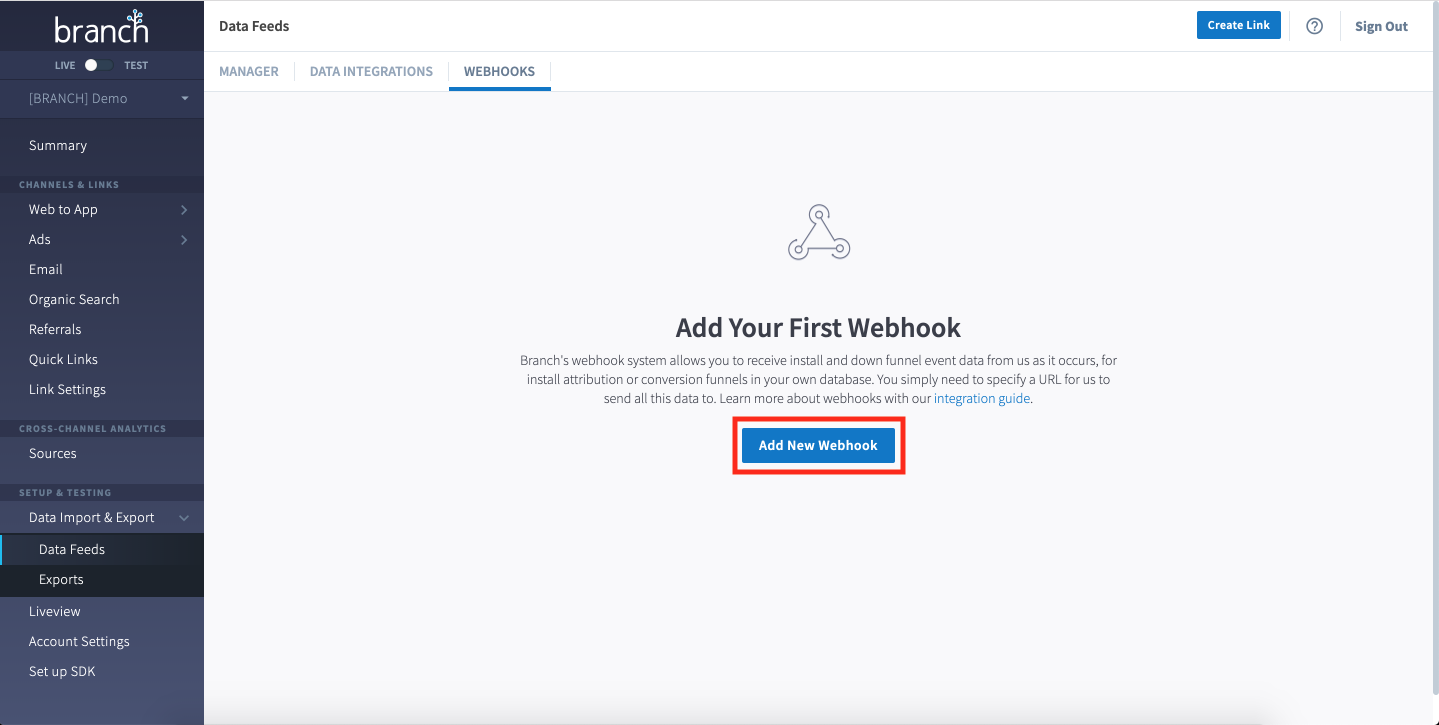
Configure webhook criteria
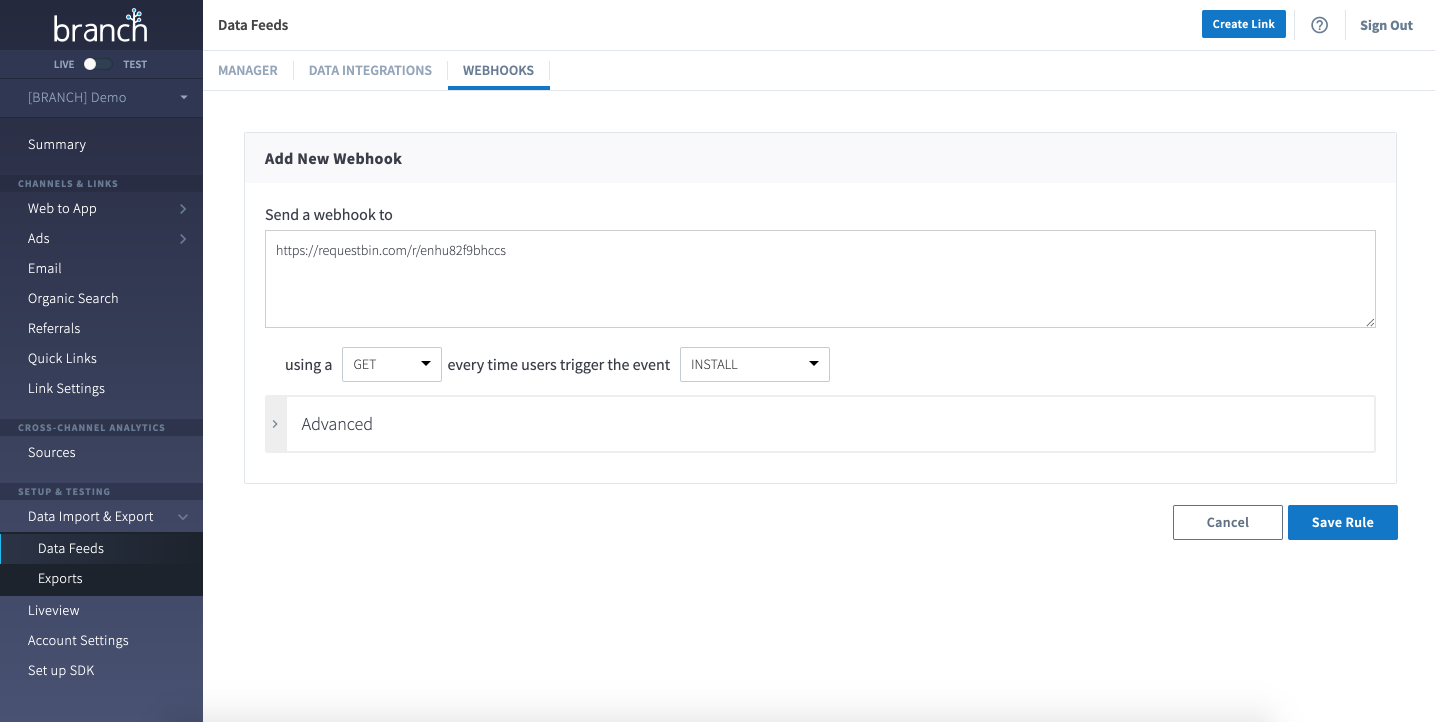
As you fill out the configuration, you'll see the following options:
- Send a webhook to: Enter the URL where you would like the events to be sent. This URL can be written with Freemarker syntax to dynamically populate parameters and execute simple, logical expressions. There is more information on Freemarker support below.
- using a GET/POST: Events can be sent either via POST or GET. POST events will be created with a default POST body. There is more information on POST bodies below.
- users trigger event: When the selected event occurs, a webhook will fire:
| Event | Description |
|---|---|
| install | Triggered the first time a user ever launches your app on their device. |
| reinstall | Triggered if a user deletes and reinstalls your app on their device. |
| open | Triggered whenever the app is opened (and the open is neither an install or reinstall) |
| web session start | Triggered when the user views a webpage using the Branch Web SDK |
| click | Triggered whenever a Branch link is clicked on any platform |
| -- additional events -- | A complete list of events you track through the Branch Web or App SDKs. |
Install Events Post iOS 14.5
Apple requires users to opt into sharing their device data through Apple's AppTrackingTransparency framework. When an install is attributed to paid ads, a 2nd install event will fire post user opt-in
Opt-ins will affect your final install count. Our recommendation is to use a different identifier (ex. IDFV) to de-dupe install events on your internal systems.
For additional information on changes post iOS 14.5, visit our FAQ Pages
Pro Tip
Events will only appear in the event dropdown if at least one of those events has been recorded in the past 30 days.
For an exhaustive list of events and more detailed definitions of each event, please see the Event Ontology Data Schema.
Event Frequency
Event frequency is not yet supported. At this time webhooks can only be sent every time an event occurs.
Basic filtering
In the Advanced section of the page you can create a filter. Only events that pass the filter criteria will be sent.
NOTE: While Branch preserves the original case of all captured data field values and case is retained through export, when webhook/postback filters are evaluated, case-sensitivity is removed. For example, if you created a filter on user_data.os, iOS, ios, and IOS are equivalent.
You'll notice a default filter that checks to see whether the event is not triggered by a known crawler/robot. To do this, we check if the Operating System does not equal "robots." With that filter applied, only events without OS equal to robots (i.e. iOS and Android) will trigger a webhook.
The most popular filter options are available in a dropdown. This should help you get up and running quickly, while also providing an example structure for more advanced filtering if you need it.
To create a filter:
- Click the Add Filter button
- Select the metadata you'd like to filter on. For example, if you only want iOS installs, select "Operating System" from the dropdown. You'll see the text field to the right populate with the correct key. When doing advanced filtering later you will select "Custom" and manually set this key.
- Select "equals" or "does not equal" from next dropdown.
- Finally, set the value of the key that you'd like to filter in or out. For example, if you want iOS installs, you'll have set up "equals" and "IOS" in the dropdowns. In this example, the robots filter is redundant, so let's remove it using the minus button.
This should be your final view before saving:
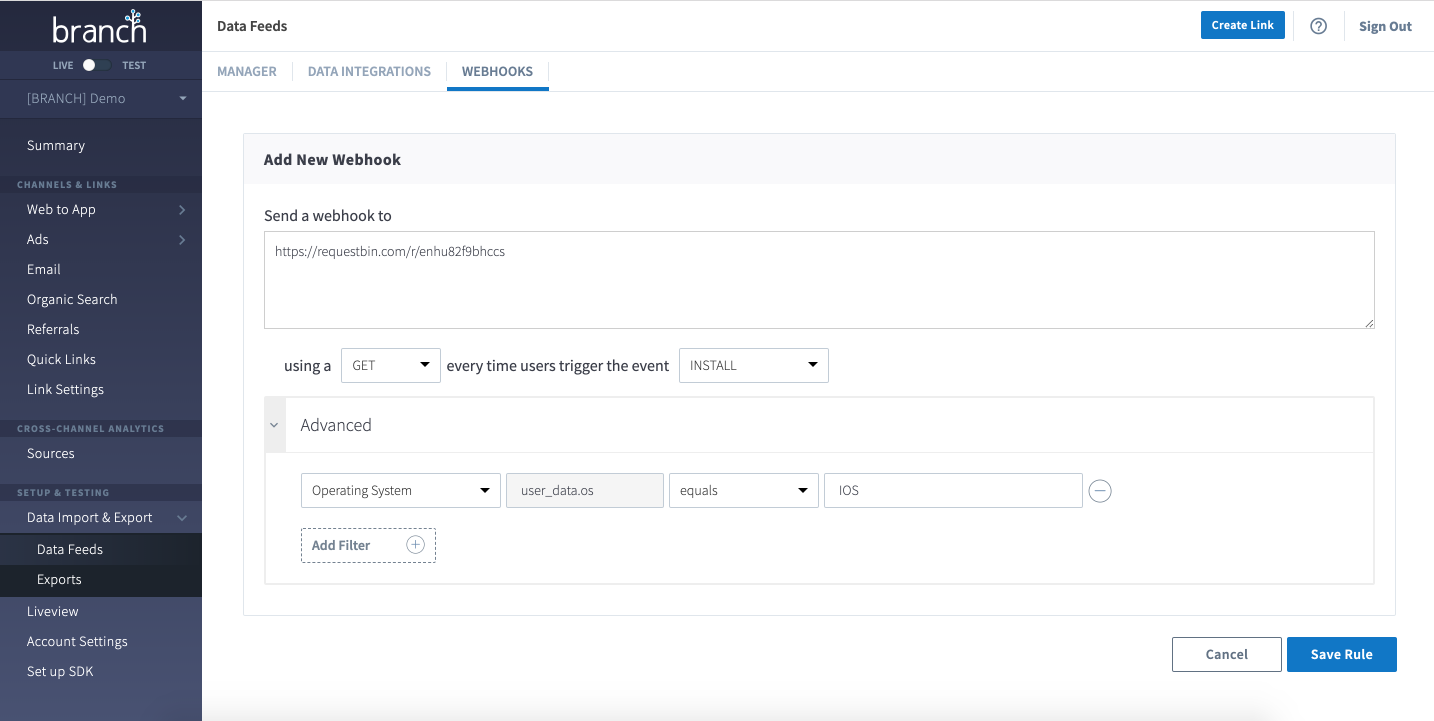
Example: Filtering installs by attributed link campaign
Let’s say you’re interested in receiving a webhook for every install event that is referred from a Branch link where you set the Campaign field to App Install Campaign. You would configure a filter to fire a webhook only when Campaign is equal to App Install Campaign. You would select Campaign from the dropdown, the key would be be autofilled and would equal last_attributed_touch_data.~campaign. Finally, you'd set the value equal to App Install Campaign.
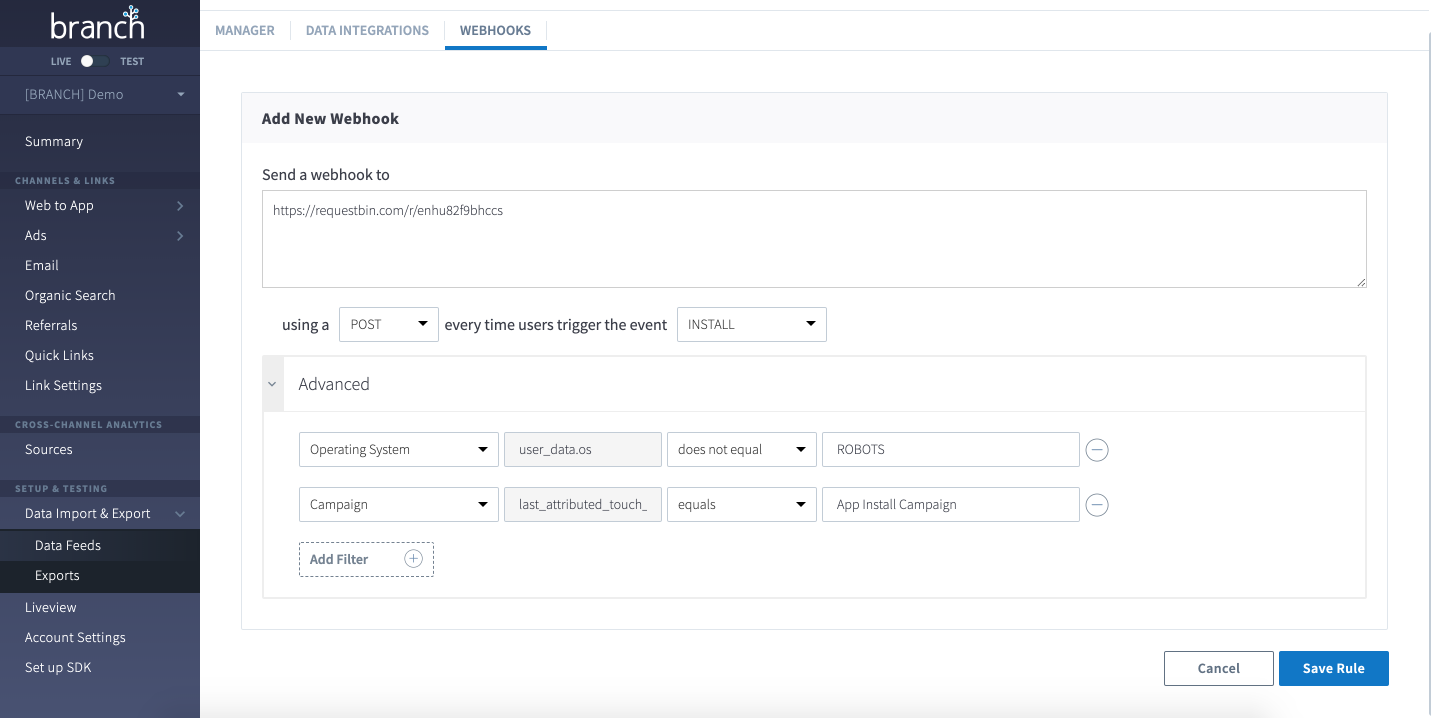
Example: Filtering clicks by link channel
Let’s say you’re interested in receiving a webhook for every click event that is referred from a Branch link where you set the Channel field to AppLovin. You would configure a filter to fire a webhook only when Channel is equal to AppLovin. You would select Channel from the dropdown, the key would be be autofilled and would equal last_attributed_touch_data.~channel. Finally, you'd set the value equal to AppLovin.
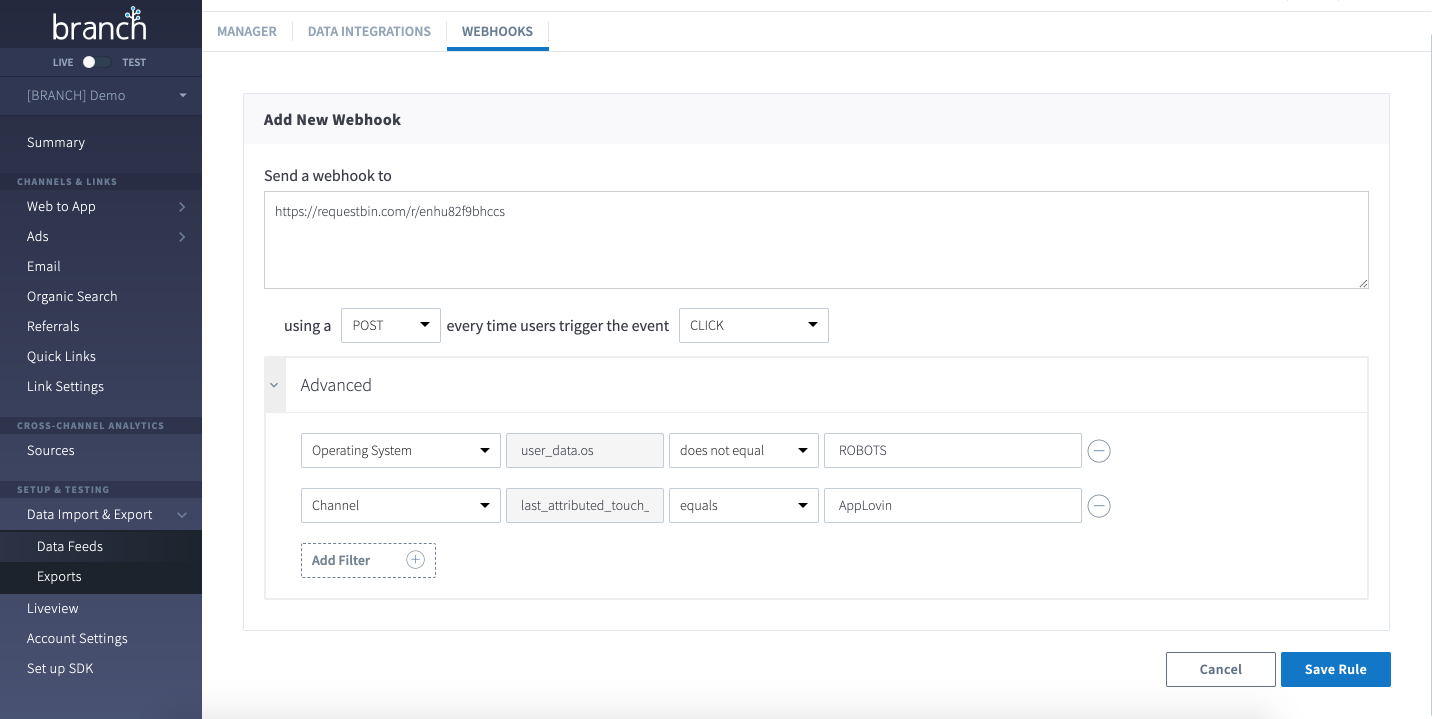
See the Advanced Filtering page to read more about customizing when events are sent.
Testing
To test whether your webhook is configured correctly, you can use RequestBin. RequestBin gives you a URL that accepts events for 24 hours and allows you to see exactly what Branch is sending.
- Go to RequestBin and click + Create Request Bin:
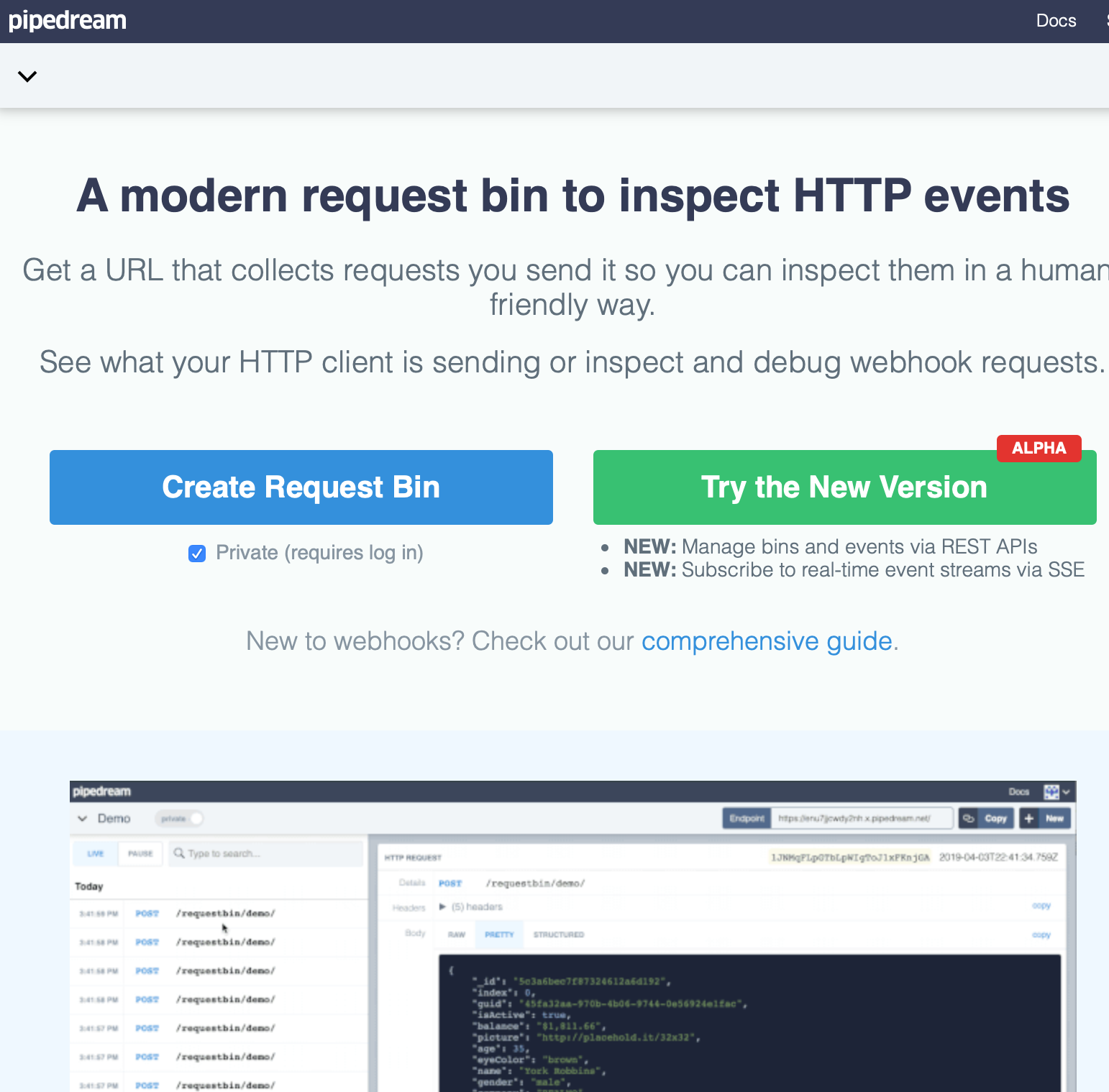
- Copy the Endpoint URL:

- Paste this into the URL field of your Branch webhook's configuration screen:
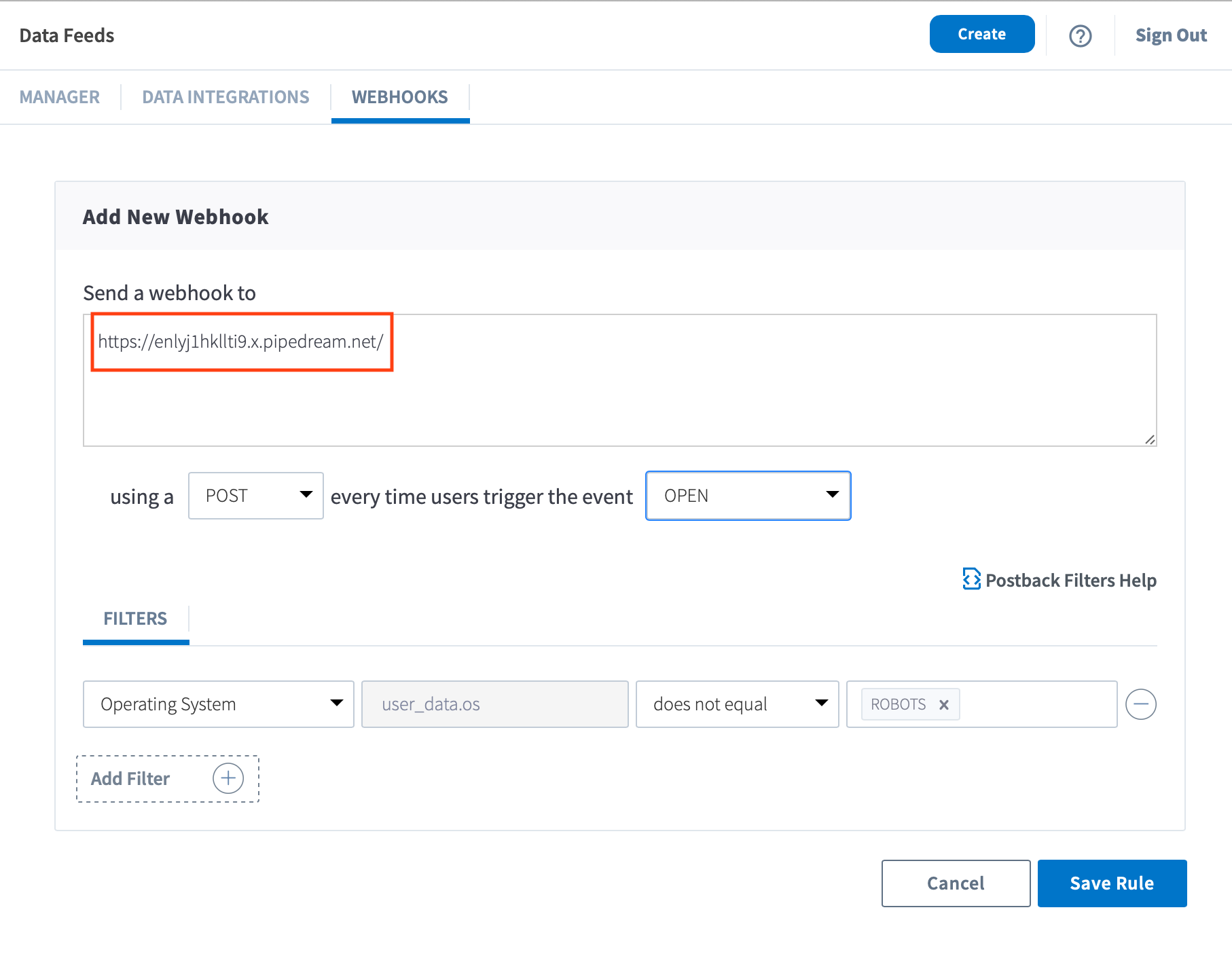
- Now whenever your webhook is triggered, you will see a full report on RequestBin:
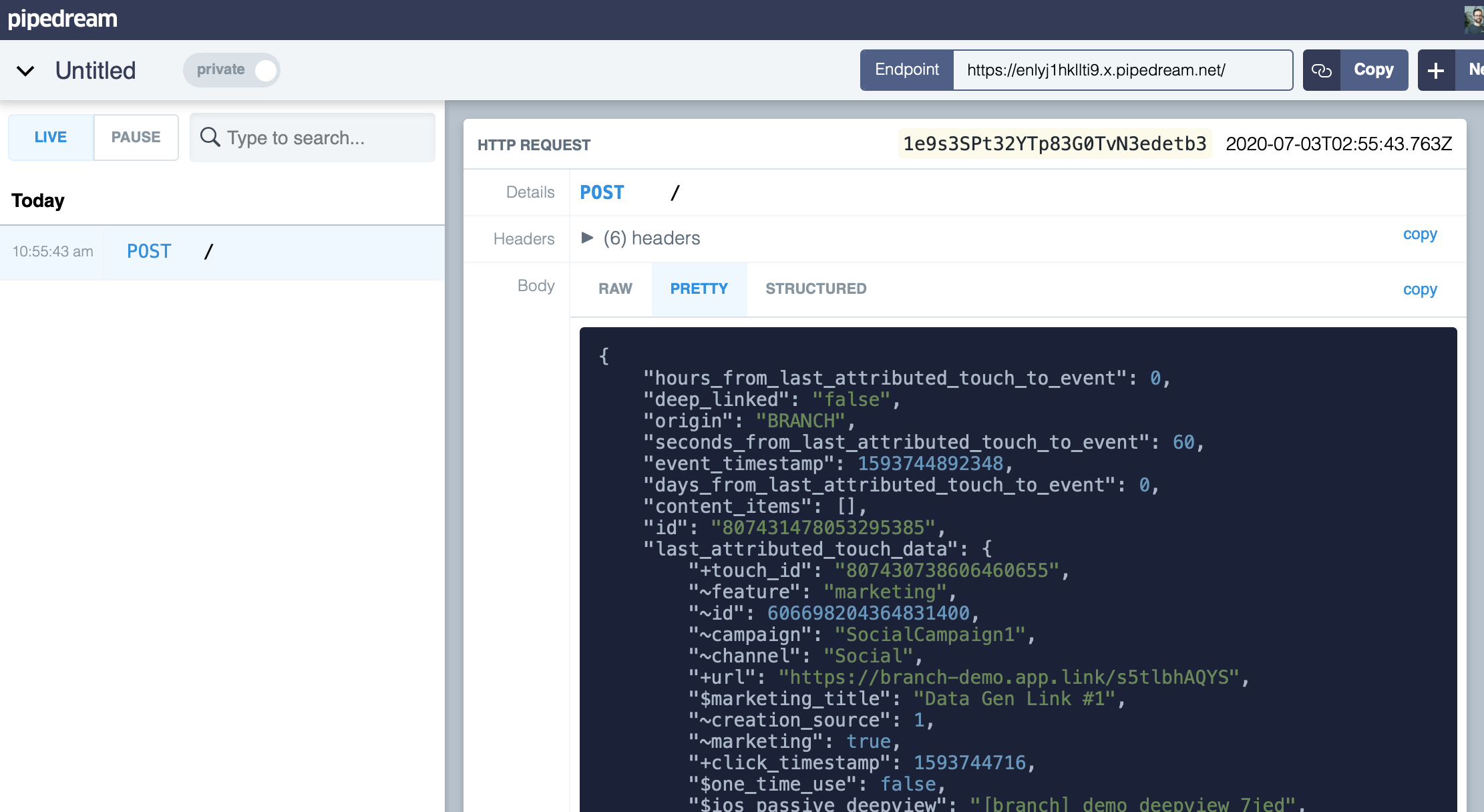
RequestBin
Please archive your Requestbin webhook when you have finished testing. Requestbins only last for 24 hours and return errors once they expire.
Data Format
Setting up Advanced Filters or Freemarker macros requires an understanding of the Event Ontology data format. Before diving into the schema, you should understand some high level concepts about event metadata structure:
- Each event has top level fields, such as "name" and "id" that are not nested
- Link data is generally nested in "Last Attributed Touch Data"
- User data (including device and OS data) is nested in "User Data"
- Product or content level data is nested in "Content Items"
- Transaction and generic content data is nested in "Event Data"
- Journeys or Deepviews view data (e.g. Journey banners loads, not clicks) is "Last CTA View Data"
- Client-specified custom data (e.g. internal fields your company requires on specific events) is nested in "Custom Data"
Full List of Available Postback Macros
To find a complete list of Branch supported postback macros, please see Postback Macros & Functions.
IP Discrepancies
Geographic data, such as country and city, may not be available for a very small percentage of events where the IP cannot be resolved to a location.
Sample webhook POST body syntax
The POST body for all webhooks follows the same structure:
POST
User-agent: Branch Metrics API
Content-Type: application/json
{
"name": "<event name e.g. open>",
"user_data": {},
"last_cta_view_data": {},
"last_attributed_touch_data": {},
"custom_data": {},
"event_data": {},
"content_items": {},
"timestamp": 'example timestamp (int)'
}
If any of these objects are empty, they will not appear in the POST body.
Here's a POST body with example data for an attributed open:
// Attributed open
POST
User-agent: Branch Metrics API
Content-Type: application/json
{
"name": "open",
"user_data": {
"os": "IOS",
"os_version": "11.1.2",
"environment": "FULL_APP",
"platform": "IOS_APP",
"idfa": "F520B35A-4165-4426-98F6-64F12F47E9BZ",
"idfv": "C6B869E7-7B0A-4A93-1C3D-960E8859DP5D",
"limit_ad_tracking": false,
"user_agent": "Mozilla/5.0 (iPhone; CPU iPhone OS 11_1_2 like Mac OS X) AppleWebKit/604.3.5 (KHTML, like Gecko) Mobile/15B202",
"ip": "50.200.105.218",
"developer_identity": "DB8C86A6-8B7C-4192-BD29-8107A5B788A1",
"country": "US",
"language": "EN",
"brand": "Apple"
},
"last_cta_view_data": {
"~id": 457624031399716729,
"~campaign": "_test",
"~feature": "journeys",
"+domain": "branchster.app.link",
"+url": "https://branchster.app.link/jeMczRn5XH",
"$deeplink_path": "open/item/1234",
"~creation_source": 5,
"+referrer": "https://store.com/products/green-table",
"foo": "bar",
"$canonical_url": "https://store.com/products/green-table",
"mydata": "set_branch_view_data_value",
"~tags": [
"tag1",
"tag2",
"bottom_banner_style"
]
},
"last_attributed_touch_data": {
"~id": 467391383381228204,
"~feature": "marketing",
"~campaign": "december_test",
"~channel": "Facebook Organic",
"product_id": "XBA8198j",
"product_name": "Green Table AB10",
"+url": "https://branchster.app.link/test_linking",
"$marketing_title": "Deep Link Testing",
"$ios_deepview": "branch_default",
"+via_features": [
"QUICK_LINKS"
]
},
"custom_data": {
"reinstall": "false",
"ip": "50.200.105.218",
"referred": "false"
},
"timestamp": 1512681005807
}
Advanced Filtering
In Basic Filtering we covered what filters do, and how to set basic filters. Branch supports more advanced filtering which allows customers to set filters based on almost any event metadata.
Make sure you've taken a look at the data format before you attempt to set advanced filters.
To create a filter:
- Click the Add Filter button
- Select the metadata you'd like to filter on. For advanced filtering, choose "Custom"
- Type in the key that you'd like to filter on. To find the key you'd like to filter on, reference our quick introduction to the Br data format to figure out where your key is likely nested. Another foolproof way to find your key is looking at your data in full before setting up your filter. You can do this by doing a CSV export, API export or send a single webhook with a POST body, and locate your key in that POST body.
- Unless your key is part of the top level data (e.g. timestamp or id), it will likely be nested one level deep. Most keys will be of the format object_name.key. For example, if you want to filter for a custom key in deep link data called "product_deeplink_id", that would take the form last_attributed_touch_data.product_deeplink_id.
Example: Filtering purchases for a specific coupon
Let’s say you’re interested in receiving a webhook for every Purchase event using a specific coupon. When you set up the Purchase event in your app or on your website, you added a specific piece of metadata for
coupon. In the Event Ontology Schema you saw thatcouponis insideevent_data. To configure your filter to fire a webhook only when coupon is equal to SUMMERDEALS10 you will:
- Select "Custom" from the filter key dropdown
- Make the key event_data.coupon
- Select "equals" on the equivalency dropdown
- Enter a value of SUMMERDEALS10
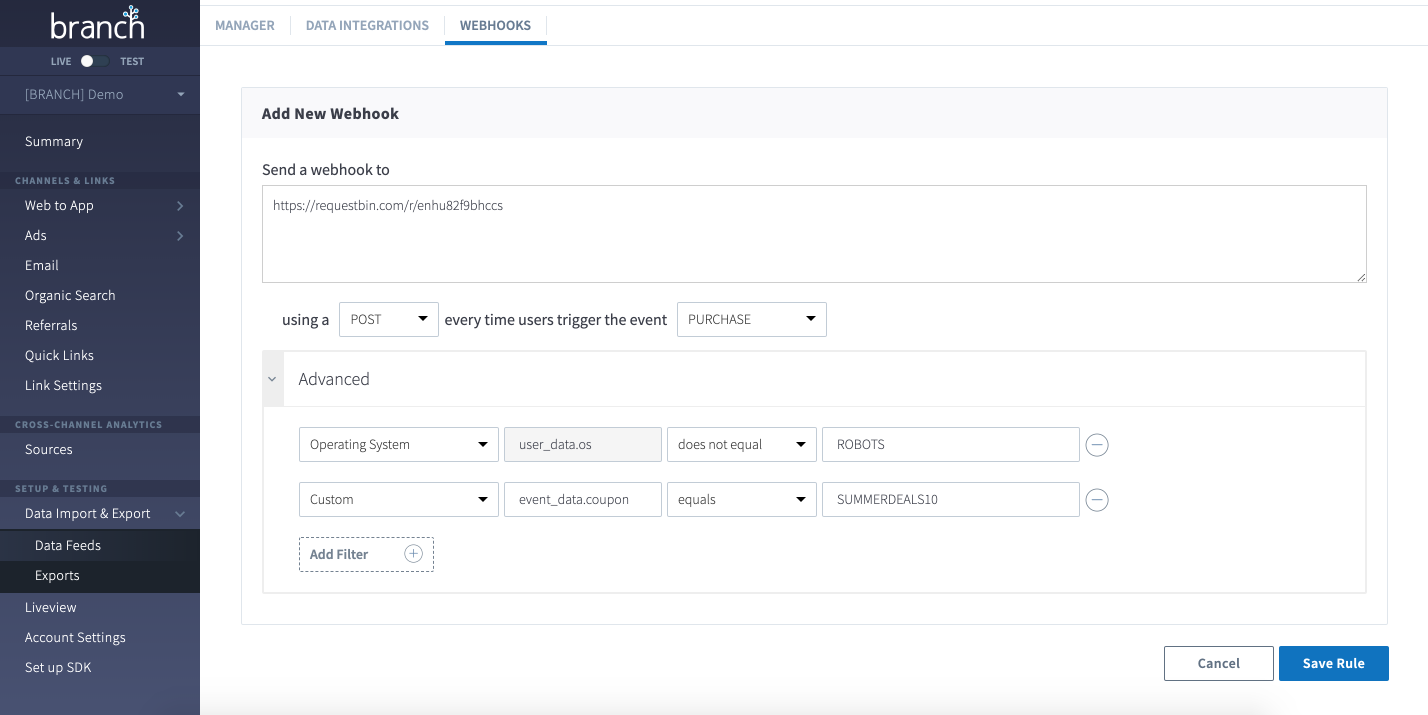
Array filtering not yet available
Currently, webhooks do not support filtering on values inside arrays. Example arrays that cannot be filtered by value are tags, +via_features and content_items.
Templating your Postback URL
If you'd like to template your postback URL, you’ll likely need to create one of our templated Postback URLs along side the aforementioned filters. These work very similarly to filters but use Freemarker syntax.
Getting started with templates
To start, we can add a simple template. Let's say we want to add campaign as a query parameter. The correct syntax is
`https://webhook.com?campaign=${(last_attributed_touch_data.~campaign)!}`
Let's walk through the syntax:
- First, find the key for the value you want to template in. As with filtering, to find the key, reference our quick introduction to the Branch data format to figure out where your key is likely nested. Another foolproof way to find your key is looking at your data in full before setting up your filter. You can do this by doing a CSV export, API export or send a single webhook with a POST body, and locate your key in that POST body.
- This exercise tells us that Campaign is nested inside
last_attributed_touch_dataand is represented bylast_attributed_touch_data.~campaign. - The additional syntax around
last_attributed_touch_data.~campaignis because Branch's templating engine uses Freemarker. In Freemarker, you can print variables by surrounding them with${}. Finally, we add()!to the variable because we want to prevent errors in the case that there is no value. - This leaves us with
${(last_attributed_touch_data.~campaign)!}.
Here is some more example Freemarker for common templates:
| Parent object | Common name | Freemarker |
|---|---|---|
| Bundle | Android Package Name | ${(bundle.android.package_name)!} |
| Bundle | iOS Bundle ID | ${(bundle.ios.bundle_id)!} |
| Last Attributed Touch Data | Feature | ${(last_attributed_touch_data.~feature)!} |
| Last Attributed Touch Data | Channel | ${(last_attributed_touch_data.~channel)!} |
| Last Attributed Touch Data | Campaign | ${(last_attributed_touch_data.~campaign)!} |
| Last Attributed Touch Data | Ad Partner Name | ${(last_attributed_touch_data.~advertising_partner_name)!} |
| User Data | OS | ${(user_data.os)!} |
| User Data | Platform | ${(user_data.platform)!} |
| User Data | IDFA | ${(user_data.idfa)!} |
| User Data | IDFV | ${(user_data.idfv)!} |
| User Data | Android Advertising ID | ${(user_data.aaid)!} |
Full List of Available Postback Macros
To find a complete list of Branch supported postback macros, please see Postback Macros & Functions.
Freemarker expressions
Due to security restrictions, Branch does not support the full list of Freemarker expressions.
Here is a list of blocked expressions:
"<#import>", "<#visit>", "<#include>", "?eval", "<#recurse>", "<#setting>", "<#macro>", "<#function>", "<#nested>", "<#return>", "<#list>"
Allowlist webhook server IP addresses
- If you need to allowlist the webhook server IP addresses for security purposes, they are listed below:
- 52.9.159.121/32
- 52.9.176.205/32
- 52.9.188.221/32
- 52.9.188.236/32
- 52.52.143.205
- 52.53.45.79
- 52.8.3.171
- 54.176.26.254
- 52.8.85.213
- 54.153.26.149
- 54.153.41.111
- 54.176.133.14
- 54.193.10.161
Authenticating webhook events
To request authentication headers for your webhooks, please Submit a Ticket.
Updated 2 months ago


